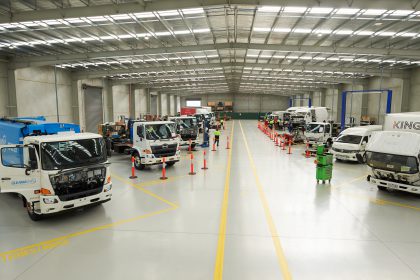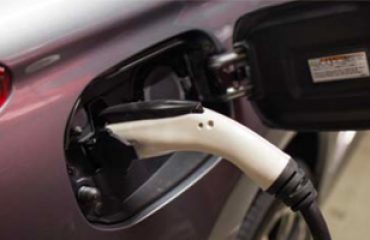
The Australia Institute’s National Energy Emissions Audit revealed the disheartening news that growth in diesel consumption, mainly in road transport, has negated gains made in carbon emissions reduction achieved in the NEM. But one Australian automotive-engineering firm has plans to transform the light-to-medium-duty diesel-slurping vehicle sector to run cleanly and quietly on electricity.

The City of Yarra is an early adopter of the SEA Electric-Isuzu medium-duty 100% electric tipper truck for rubbish collection. Image: SEA Electric
ShareIcon FacebookIcon TwitterIcon LinkedInIcon Google PlusIcon WhatsAppIcon Email
On Friday, Melbourne-based automotive technology company SEA Electric received its first three-figure order — 100 Hino 195s fitted to run on electric power — from US commercial electric vehicle (CEV) service provider Zeem Solutions.
The 100% electric medium-duty trucks will be assembled under license in the US by Fontaine Modifications which will upfit them with SEA-Drive 120a power systems. Designed in Australia, these motors deliver a range of up to 320 kilometres, 80 kW (110 horsepower) of continuous power, torque of 150 kg/m (1,500 Nm) and zero emissions.

US electric vehicle service provider, Zeem Solutions, has ordered 100 electric-powered Hino commercial vehicles under license from Australian SEA Electric. This chassis is the basis of the trucks soon to be quietly plying the streets of Los Angeles and Sacramento. Image: SEA Electric
Mechanical engineer Tony Fairweather, founder and President of SEA Electric, launched the company’s 100% electric power trains in 2017 after four years of product development and testing, at the moment when battery prices had reduced sufficiently to make electric drivetrains viable in the global market.
The company works with Hino, Isuzu, Iveco, Mercedes Benz and Dennis Eagle manufacturers to modify their commercial vehicles — rigid-chassis, two- and three-axle vans, medium-sized trucks and buses — to run on battery power.
“Battery technology has developed at an exponential rate in the past decade and prices have come down significantly, although they’re still in the range of US$250 per kilowatt hour,” Glen Walker, SEA Electric’s Regional Director for Oceania, tells pv magazine.
Radically reduced running costs
Whole-of-life operating costs make the premium paid for SEA Electric driven vehicles worthwhile on a purely economic basis, says Walker: “Even without [government] incentive, our vehicles cost less to own over the lifetime of those vehicles.”
With only one moving part — the electric motor itself — electric motors are far cheaper to run than petrol or diesel engines. “Maintenance, repairs and fuel are the three main things that have a dramatic impact on reducing that whole-of-life operating costs of our motors, to the point where the upfront purchase price premium is fully recovered in about four years; or every month if you’re on a monthly hire-purchase arrangement,” says Walker.
This year SEA Electric has made a string of announcements, including the availability of its SEA-Drive 100-powered Isuzu NPR 65-190 tipper truck; and the SEA-Drive 120b-powered Isuzu FTR-chassis elevated work platform (EWP) truck — a cherry picker with 2,500 Nm of torque, 150 kW continuous power and 250 kW maximum power.
New Zealand electricity distribution company WEL Networks was the first to purchase a SEA Electric EWP — with its motor capable of operating the elevated platform and travelling 200 km on a single charge — for use in line maintenance.
“We believe electric vehicles will play a really important part in New Zealand’s energy future,” said WEL Networks’ Chief Executive, Garth Dibley, who announced the vehicle’s deployment on 29 September. “By investing in electric trucks, we’re not only generating fewer emissions, but also helping to future proof our business and community.”
Diesel emissions run over GHG reductions in the NEM
The National Energy Emissions Audit (NEEA) for October 2019, released last month by The Australia Institute (TAI) brought home the relevance of diesel consumption in Australia. It showed that an increase in diesel combustion emissions of 21.7 Mt CO2-e — generated mainly by increases in diesel consumed by road transport and mining operations — over the period between the financial year 2011 to FY18 almost completely wipes out the decrease of 22.1 Mt CO2-e in emissions from electricity generation due to renewable generation entering the NEM over the same period.
NEEA author Hugh Saddler writes, “New and improved data shows that almost all the growth in diesel fuel is coming from increased retail sales of diesel, meaning diesel consumption by passenger and commercial vehicles.”

Road transport is a huge driver of growth in diesel consumption in Australia and resulting increasing GHG emissions. Graph: TAI
Although Australian governments have acted to improve the fuel efficiency of heavy road freight vehicles, little has been done to encourage efficiency in the light to medium-range of vehicles.
Missing electrifying incentive in Australia
SEA Electric’s Tony Fairweather notes that, “The Hino 195 EVs will be deployed in California, a reflection on the excellent incentive program facilitated by CARB and CALSTART.”
California Air Resource Board (CARB) Regulations were introduced in 2008, to reduce the greenhouse gas emissions of the estimated one million heavy-duty trucks that operate in California and have consistently been revised to drive greater reductions in road-transport emissions; while CALSTART is a not-for-profit organisation which provides services and consulting to accelerate advanced transportation technologies.
The development of the EWP first deployed by WEL Networks was a combined project of SEA Electric and CAL Isuzu in Hamilton, New Zealand, and was partly funded by New Zealand’s Energy Efficiency and Conservation Authority’s (EECA) Low Emission Vehicles Contestable Fund.
“The aim of the Fund is to drive innovation and grow confidence in an electrified vehicle fleet,” said Richard Briggs, Manager of Programme Partnerships at EECA. “Projects like this will show other heavy vehicle operators what’s possible and encourage them to invest in decarbonising their fleets.”
Solar PV leads the charge
WEL Networks already has a fleet of electric vehicles and more than 20 electric vehicle chargers in the Waikato region where it operates. Its new EWP takes between four and eight hours to fully recharge.

Pick of the cherry pickers runs 100% on electricity for WEL Networks in NZ. Image: SEA Electric
For any single SEA Electric CEV, Walker says charging by three-phase power at any fleet depot is completely viable, and the cost of running the vehicle is further reduced if the depot or business receives part or all of its energy from renewable sources — whether generated by onsite solar, solar and battery systems, or purchased via renewable power-purchase agreements or from utilities offering renewable-energy contracts.
Installation of high-speed DC chargers represents a significant capital outlay to businesses looking to adopt a fleet of commercial electric vehicles, but utilities and councils are among the likely first movers — with their operations paid for by their constituents and community pressure to decarbonise.
The City of Yarra council, for example, is running SEA’s first electric tipper truck, based on an Isuzu NPR 65-190 platform, for its hard rubbish collection.
In suburban environments, “not having exhaust emissions is a significant practical advantage of a CEV” Walker tells pv magazine.
As batteries reduce in cost, he says, the economics become ever more persuasive, “But as the expectation and the demand for cleaner and quieter urban environments increases, the rationale becomes quite different and there becomes an imperative to doing it. It’s not just a nice to have.”
The world is your noiseless oyster
Walker, who has worked in commercial transport for many years, says he was surprised, if not shocked, by the experience of first driving an SEA commercial electric vehicle. The power and responsiveness were indistinguishable from that of a diesel engine, but the silence in the absence of engine noise was deafening.
“You can hear the radio, you hear the wind rushing past the side-view mirror, but the main thing you hear is tyre noise — I thought, ‘Oh my goodness, tyres are loud!’”
He believes drivers of electric vehicles will experience less fatigue, because of both noise and fume reduction, than those who spend their days behind the wheel of fossil-fuel-powered engines.
In urban environments, where service or delivery vehicles would be hard-pressed to cover anywhere near 200 km in a day, the currently available battery density and efficiency already makes sense, as SEA Electric’s 130-plus vehicle sales (pre Zeem Solutions’ order) in Australia, New Zealand, the US and Thailand attest.
TAI’s Hugh Saddler writes that, “Much of the public debate about climate and energy policy fails to recognise the importance of emissions from use of petroleum fuels, especially diesel, to the extent that comments often seem to suggest that energy is synonymous with electricity.”
In fact the ability of growth in diesel use and emissions to all but eliminate gains from renewable energy’s reduction of carbon emissions from the electricity sector shows that “consumption of diesel should be receiving far more attention than it has done to date in discussions of how to reduce Australia’s greenhouse gas emissions”, Saddler says. READ MORE
PV Magaine Australia, November 18, 2019 by Natalie Filatoff




